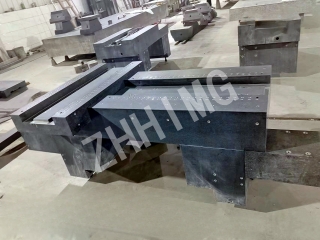In the world of semiconductors and related equipment, the base on which the various tools and machines stand is of great importance. This is because it is the foundation of the entire equipment and therefore needs to be strong, stable and long-lasting. Among the several materials that are used for making such bases, granite has emerged as one of the most popular and reliable materials. In this article, we will explore the various advantages of using granite as a base for semiconductor equipment.
Granite is a natural stone that has outstanding mechanical and thermal properties, making it the perfect choice for the base of semiconductor equipment. The most significant benefits of using granite for this purpose are its superb rigidity, high wear resistance, and superior stability. The following are some of the advantages of using granite as a base:
1. High rigidity:
Granite is a dense, hard rock that has excellent rigidity. This feature makes it better at handling vibration and shocks than other materials. It also ensures that the surface of the granite base remains flat and level, even when exposed to high pressure, ensuring the accuracy of the equipment.
2. Superior thermal stability:
The thermal stability of granite is unmatched. Being a natural stone, it has a very low coefficient of expansion, which means that it responds very little to temperature changes. This property makes it the ideal choice for equipment that operates at extreme temperatures, such as wafer processing tools and lithography machines.
3. Low thermal conductivity:
The thermal conductivity of granite is very low, almost 10 times lower than many other materials. This low thermal conductivity value makes it very effective at absorbing and distributing heat uniformly. As a result, equipment that is placed on a granite base will run cooler, thereby reducing the risk of overheating and thermal fracture.
4. Low coefficient of friction:
Granite has a low coefficient of friction, which means that both the equipment and the base will experience less wear and tear due to friction. This feature also ensures that there is less strain on motors, bearings, and other moving components of the equipment. This not only prolongs the life of the equipment but also reduces the downtime required for maintenance.
5. High corrosion resistance:
Granite has excellent corrosion resistance and is not affected by chemicals and acids used in semiconductor processing. This property ensures that the equipment and the base remain unaffected by the aggressive solvents, gases, and chemicals commonly used in the semiconductor industry.
6. Aesthetic value:
In addition to its technical advantages, granite also has impressive aesthetic value. It gives equipment an upscale look that is both impressive and professional.
In conclusion, using granite as a base for semiconductor equipment has several advantages. Its superb rigidity, thermal stability, low thermal conductivity, coefficient of friction, corrosion resistance, and aesthetic value make it the ideal choice for semiconductor equipment. By choosing granite as a material for the base, equipment manufacturers are sending a message that they prioritize the safety, accuracy and longevity of their machinery, and that's something that the industry can appreciate.
Post time: Mar-25-2024

